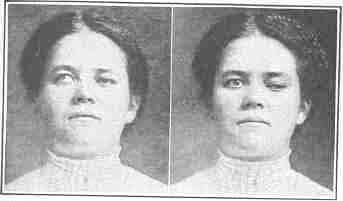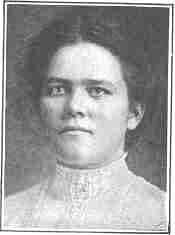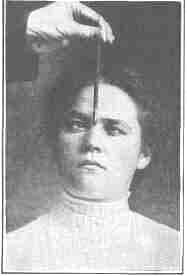Strengthening the Eyes
by Bernarr A. MacFadden, Strengthening the Eyes; A System of Scientific Eye Training.
CHAPTER XI
Saving the Sight of the Children
In the following pages the first successful attempt to cure defective vision and prevent myopia in schools is described. The details may be found in the New York Medical Journal, July 29, 1911 [link], and August 30, 1913 [link], and are worthy of more attention than they have received. The prevention of myopia among school children is of vital and far-reaching importance. Eye defects, with the nervousness, headaches and irritability for which they are responsible, not only prevent children from availing themselves of the educational opportunities offered to them by the state, but are often a serious handicap as well as a discomfort and an expense in after life. If there is any way of preventing such tragedies it ought to be adopted without a moment's delay. Meantime parents can protect their children by using the methods advocated at home. Since it is difficult to prove a negative proposition, it cannot, of course, be absolutely proven that these methods actually prevented myopia, but since all cases of defective eyesight were improved by them there can be no reasonable doubt that they also prevented this condition.
ONE of the most serious problems which civilization has been called upon to solve is that of saving the sight of children. Ever since the introduction of popular education it has been recognized that the system was disastrous to the eyesight of the rising generation. Voluminous statistics, collected both in this country and in Europe, show that whereas most children on entering school have perfect sight, the percentage of eye defects steadily increases during the educational process, reaching its climax in the higher institutions of learning.
In Europe, where the military system has made the matter one of great practical importance to the State, much effort has been made to find a remedy for the evil, and millions of dollars have been spent in carrying out the suggestions of the eye specialists. The lighting of the schools, the furniture, the print in the school books, the position assumed by the pupils at work, were all regulated in accordance with expert opinion. In some cases the suggested reforms were carried out with such thoroughness that "face-rests" were attached to the desks to prevent the children from getting their eyes too near their books.
The injurious effects of the educational process were not, however, appreciably arrested. Cohn reports, indeed, an increase both in the percentage and degree of myopia in those schools in which he had especially exerted himself to secure reforms, while Just found that the excellent hygienic arrangements in the high school of Zittau, where he examined the eyes of 1,229 of the pupils, had not in any degree lessened the percentage of myopia.
All these efforts to prevent myopia failed because they were based on a wrong conception of the cause of the condition. It was naturally supposed that the cause of the failure of the eye tosee distant objects was its too constant use for near work; but this theory is gradually giving way before statistics, and the orthodox writers have now fallen back on that convenient scapegoat, heredity, for an explanation. Since some people are able to use their eyes continuously for near work without getting near-sighted, and others get near-sighted without any appreciable amount of such work; since the limitation of such work fails to check the progress of the trouble; and since domestic animals and wild animals in captivity, although they neither read nor sew, develop high degrees of myopia (as shown in numerous investigations);—there is obviously some other influence at work, and this influence is now supposed to be heredity.

A case of divergent vertical squint ultimately cured by educational methods. In the picture at the left the right eye turns out and up, while the left eye looks straight. At the right the patient has learned to look straight with the right eye, while the left turns down and out.
It is known that people are rarely if ever born myopic, but they are supposed to be born with a tendency to that condition, and near work is generally believed to accentuate this tendency. As there is no way of finding out who has this unfortunate bent and who has not, the old precautions are, therefore, still insisted upon for the most part, although some authorities attach very little if any importance to them, maintaining that when one has the myopic tendency one might as well resign oneself to one's fate and not bother with tiresome precautions.
As a matter of fact the retinoscope has demonstrated that straining to see at the near-point never produces myopia, but, on the contrary, hypermetropia, as already noted in Chapter V, on "The Imperfect Sight of the Normal Eye." Myopia is produced by straining to see distant objects, and it has been found that it is produced whenever children with normal vision strain to see unfamiliar distant objects. (See also Chapter V.)
When regarding familiar distant objects it is quite otherwise. Daily exercise in the distant vision of familiar objects, therefore, suggests itself as the best method of preventing the tendency to strain in viewing unfamiliar distant objects and thus of preventing permanent myopia and hypermetropia. This method has been tried in many public schools during the last fifteen years and has been uniformly successful, not only in preventing myopia, but in curing it where it already existed.
The Snellen test card was found to be the best distant object for exercises in distant vision. When memorized it becomes a familiar distant object. Its daily use for half a minute or longer both prevented and cured myopia, and also improved the vision for near objects, many pupils stating that they were able, after its introduction into the classroom, to study with less or no discomfort. The test card was placed permanently where all the pupils could see it from their seats, and the children were instructed by the teachers to read it daily with both eyes together and with each eye, separately, the other being covered with the palm of the hand in such a way as to avoid pressure on the eyeball. Records of vision were made either with the same card or with an unfamiliar one.

The same patient after a complete cure had been effected. All four pictures were taken within fifteen minutes of each other, the patient having learned to reproduce voluntarily the conditions represented.
This method of preventing myopia was used for eight years continuously in the public schools of Grand Forks, North Dakota, and reduced the percentage of myopia from six to one per cent.
Later it was introduced into a number of public schools in New York with a total attendance of ten thousand children. The cards were received with considerable scepticism, the teachers being unable to believe that such a simple method, and one so entirely at variance with previous teachings on the subject, could produce results. Some of the teachers neglected to use them, but others, in spite of their miscellaneous and often trying duties, gave the matter serious attention, and were able to present complete reports covering five thousand children. Of this number three thousand had defective eyesight and the reports showed that more than a third of this number gained perfect vision in both eyes after the test cards were introduced.

A part of the treatment. The patient has learned to turn both eyes in by looking at a pencil held over the bridge of the nose. Later she became able to turn them in without the pencil, or to turn either eye in while the other remained straight.
In one case in which there had been twenty-seven defectives in a class, twenty-five were reported cured and two much improved, while one incorrigible and one truant had become good students because, after they had obtained normal vision, they were able to study without pain or discomfort.
The Snellen test card was devised by Herman Snellen, Professor of Ophthalmology in the University of Utrecht, for the purpose of testing the sight by means of letters and figures of different sizes, but it has been found equally valuable for eye training. Each line is designated by a number indicating the distance in feet at which it should be read, but this is only a minimum standard. Many people become able to read the various lines at twice the distances marked and a few at three times these distances. The records of vision are written in the form of a fraction, the upper line (numerator) indicating the distance in feet of the reader from the card, and the lower (denominator) the line read. When the numerator and denominator are equal, the sight is normal. The school records were made as follows, the vision of each eye being recordedseparately:
| February, 1913 | April, 1913 | June, 1913 | ||||
| R. | L. | R. | L. | R. | L. | |
| John D. | 20/100 | 20/50 | 20/50 | 20/40 | 20/20 | 20/20 |
| Sanford G. | 20/50 | 27/70 | 20/30 | 20/40 | 20/15 | 20/20 |
That the improvement shown by the records was due to the use of the cards was demonstrated not only by the fact that when the cards were removed relapses occurred where improvement had not been sufficient to establish its permanence, but also by comparative tests made with and without cards. In one case six pupils with defective sight were examined daily for one week without the use of the test card. No improvement took place. The same six pupils were then given daily exercises in distant vision with the test card. At the end of that time they had all improved and five were cured. In the case of another lot of six defectives in the same school the results were similar. No improvement was noted during the week that the card was not used, but after a week of exercises in distant vision all had shown marked improvement, while at the end of a month all were cured.
In a considerable proportion of cases the children learned in a few minutes how to look at things without effort and were thus cured of their myopia. Many of the teachers were also cured of eye troubles and enabled to discard their glasses.
| Eyes carePhysicianBate's booksTechnologyForumLaser corre.Blues under eyesburning in the eyesanother diseasesMedical mistery Naturally eyesight correction. No laser eye surgery. Restore eyesight. Vision correction. |




